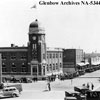Lloydminster’s Growth in the Post-War Era (1945-1980)

After the Second World War, Lloydminster’s oil industry became its most important industry, boosting the town’s economy and setting off a real estate boom. The first important step in this transformation was the building of the Husky Oil refinery on the outskirts of the city. The very next year the plant’s capacity was doubled. By 1949, there were 200 oil-producing wells within the vicinity of Lloydminster. The oil produced in the area was heavy oil, ideal for use in producing asphalt and bunker fuel for railways. When the railways switched to diesel in the mid-1950s, asphalt-based companies flooded in to town to take advantage of Lloydminster’s wealth of black gold. Some of the asphalt plants that came during the 1950s were the Sidney Roofing Company’s plant, a road asphalt plant, and another general purpose manufacturing plant for asphalt products.
Oil brought economic prosperity to the region. Improvements to waterworks and a new natural gas system also increased Lloydminster’s prestige. The result was a wave of newcomers to the area, accompanied by a modest building boom. Nelson Lumber was formed in 1949 to fulfill the growing demand for building lumber. Nine years later, Nelson Homes, one of Lloydminster’s most important industries at the time, was founded and began building homes and transporting them across Western Canada. The success of Nelson Homes, in turn, attracted more businesses and workers to the area.

Between 1951 and 1956, Lloydminster’s population rose from 3938 to 5013. By 1956, the city had an airport, a new high school, a Husky Truck Stop, two theatres, two halls, two covered rinks, and one of the largest co-operative stores in Canada. Although it was still a small settlement, Lloydminster was on its way to becoming an officially recognized city with building permit amounts reaching nearly one million - $851,303 in 1953 and $807,181 in 1954. Building permits topped a million in 1958, skyrocketing to $1,583,250. That same year, Lloydminster was incorporated as a city.
During the early 1960s, the City of Lloydminster’s growth was modest and its residential area remained small. Some important building projects at the time were the Reaves Business College (1961), the Parkland School (1966) for children with learning disabilities, and the restoration of St. John’s Minster, the oldest building in the city. Previously, the church had been used as a church, a school house, a general store, and a bottle exchange. The Minster or “Mother Church” was relocated to Weaver Park and officially renamed “The Old Minster Church” in 1968.
During the second half of the 1960s, the oil industry heated up. In 1963, construction began on an oil pipeline from Lloydminster to Hardisty, Alberta. New technology to improve oil recovery and growing markets in the United States led to a renewal of Lloydminster’s oil industry. More steam plants and batteries were constructed by Husky Oil in and around Lloydminster.

Husky Oil remained one of Lloydminster’s most important employers during the 1970s, but new oil companies and petroleum related businesses began to set up shop in town. Lloydminster’s first industrial park, Hill Industrial was built in 1973. The same year, United Oilseeds Products opened a canola crushing plant in the area. Hill Industrial Park was soon filled up, and by 1979, Glenn E. Nielson Industrial Park was created to accommodate the new Universal Industries plant to manufacture oil equipment. New businesses also came to Lloydminster to take advantage of the rich supply of heavy oil; for example BMW Monarch opened a sales and repair centre in 1975.
Lloydminster’s status was rising, made evidence by the fact the small city was chosen as the corporate centre for Lakeland College in 1974. Furthermore, Lloydminster Mall opened to customers around this time. But on the eve of the new city’s success, a recession loomed around the corner that would hit the oil industry hard and Lloydminster along with it.
References
Alberta Department of Business and Tourism. “ Lloydminster Community Survey, 1974.”
Alberta Department of Industry and Development. “City of Lloydminster, 1961”.
Foster, Franklin Lloyd and Alan Grant Griffith. Bordering on Greatness: A History of Lloydminster’s First Century 1903-2003. Lloydminster: Foster Learning Inc., 2001.
Industrial Development, Branch Department of Economic Affair, Alberta Government. “Survey of Lloydminster, 1956.”
“ Lloydminster: From Oxcart to Oilwell, 1903-1950.” Lloydminster High School Essay Club, 1950.



